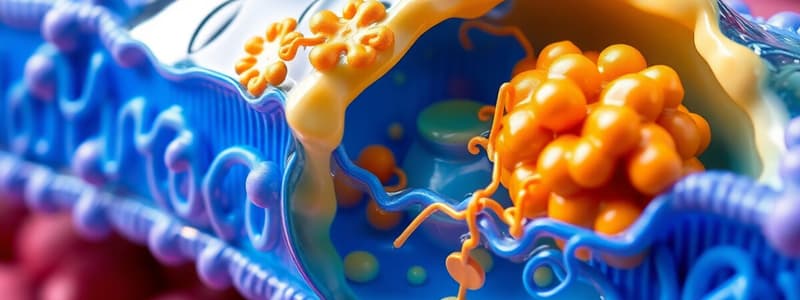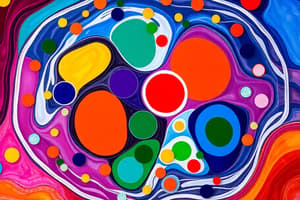Podcast
Questions and Answers
Which type of passive transport requires specific protein channels?
Which type of passive transport requires specific protein channels?
- Simple diffusion
- Facilitated diffusion (correct)
- Osmosis
- Active transport
What is the driving force behind diffusion?
What is the driving force behind diffusion?
- Electrochemical gradients
- Osmotic pressure
- Concentration gradients
- Kinetic energy of molecules (correct)
In which direction do materials move during passive transport?
In which direction do materials move during passive transport?
- From low to high concentration
- Against the concentration gradient
- From high to low concentration (correct)
- Randomly in all directions
What factor does NOT affect the rate of diffusion?
What factor does NOT affect the rate of diffusion?
Which of the following molecules is most likely to undergo simple diffusion?
Which of the following molecules is most likely to undergo simple diffusion?
What condition must be met for diffusion to stop?
What condition must be met for diffusion to stop?
In which situation would osmosis occur?
In which situation would osmosis occur?
Which type of transport does NOT require energy from ATP?
Which type of transport does NOT require energy from ATP?
What function does the cell membrane primarily serve?
What function does the cell membrane primarily serve?
Which of the following statements about the fluid mosaic model is true?
Which of the following statements about the fluid mosaic model is true?
What is the role of glycoproteins in the cell membrane?
What is the role of glycoproteins in the cell membrane?
What characterizes the polar regions of the plasma membrane?
What characterizes the polar regions of the plasma membrane?
Which of the following correctly describes nonpolar and polar interactions in the cell membrane?
Which of the following correctly describes nonpolar and polar interactions in the cell membrane?
Which part of the plasma membrane is hydrophobic?
Which part of the plasma membrane is hydrophobic?
What type of transport involves the movement of materials across the cell membrane without energy input?
What type of transport involves the movement of materials across the cell membrane without energy input?
Which is NOT a characteristic of the cell membrane?
Which is NOT a characteristic of the cell membrane?
What happens to a cell placed in a hypertonic solution?
What happens to a cell placed in a hypertonic solution?
Which of the following correctly describes hypotonic solutions?
Which of the following correctly describes hypotonic solutions?
What type of transport is primarily used for the movement of glucose across a cell membrane?
What type of transport is primarily used for the movement of glucose across a cell membrane?
What is the result of placing an animal cell in a hypotonic solution?
What is the result of placing an animal cell in a hypotonic solution?
Which solution has equal solute concentrations inside and outside the cell?
Which solution has equal solute concentrations inside and outside the cell?
How do paramecium deal with osmotic pressure?
How do paramecium deal with osmotic pressure?
What is turgor pressure?
What is turgor pressure?
What is the significance of kidneys in maintaining isotonic blood?
What is the significance of kidneys in maintaining isotonic blood?
What happens to an animal cell when it is placed in a hypotonic solution?
What happens to an animal cell when it is placed in a hypotonic solution?
When a plant cell is placed in a hypotonic solution, what is the primary outcome?
When a plant cell is placed in a hypotonic solution, what is the primary outcome?
What is the effect on an animal cell placed in a hypertonic solution?
What is the effect on an animal cell placed in a hypertonic solution?
How does an isotonic solution affect a plant or animal cell?
How does an isotonic solution affect a plant or animal cell?
What structural feature in plant cells helps prevent them from bursting?
What structural feature in plant cells helps prevent them from bursting?
What happens when a saltwater fish is placed in fresh water?
What happens when a saltwater fish is placed in fresh water?
Why do you become thirsty after eating salty food?
Why do you become thirsty after eating salty food?
What is the primary requirement for active transport in cells?
What is the primary requirement for active transport in cells?
Flashcards
Homeostasis (Cell Membrane Function)
Homeostasis (Cell Membrane Function)
The cell membrane acts as a barrier, controlling what enters and exits the cell, ensuring the cell's internal environment remains stable.
Selectively Permeable Membrane
Selectively Permeable Membrane
The cell membrane allows some substances to pass through while blocking others. This selectivity is crucial for maintaining proper cell function.
Protection & Support (Cell Membrane Function)
Protection & Support (Cell Membrane Function)
The cell membrane acts as a protective barrier, shielding the cell from its surroundings. It also provides structural support, maintaining the cell's shape.
Universal Presence of Cell Membrane
Universal Presence of Cell Membrane
Signup and view all the flashcards
Fluid Mosaic Model
Fluid Mosaic Model
Signup and view all the flashcards
Lipid Bilayer
Lipid Bilayer
Signup and view all the flashcards
Membrane Proteins
Membrane Proteins
Signup and view all the flashcards
Glycoproteins
Glycoproteins
Signup and view all the flashcards
Passive Transport
Passive Transport
Signup and view all the flashcards
Simple Diffusion
Simple Diffusion
Signup and view all the flashcards
Facilitated Diffusion
Facilitated Diffusion
Signup and view all the flashcards
Osmosis
Osmosis
Signup and view all the flashcards
Concentration Gradient
Concentration Gradient
Signup and view all the flashcards
Equilibrium
Equilibrium
Signup and view all the flashcards
Active Transport
Active Transport
Signup and view all the flashcards
Solute Concentration
Solute Concentration
Signup and view all the flashcards
Hypertonic
Hypertonic
Signup and view all the flashcards
Hypotonic
Hypotonic
Signup and view all the flashcards
Isotonic
Isotonic
Signup and view all the flashcards
Phagocytosis
Phagocytosis
Signup and view all the flashcards
Pinocytosis
Pinocytosis
Signup and view all the flashcards
Hypertonic Solution
Hypertonic Solution
Signup and view all the flashcards
Hypotonic Solution
Hypotonic Solution
Signup and view all the flashcards
Isotonic Solution
Isotonic Solution
Signup and view all the flashcards
Plasmolysis
Plasmolysis
Signup and view all the flashcards
Cytolysis
Cytolysis
Signup and view all the flashcards
Turgor Pressure
Turgor Pressure
Signup and view all the flashcards
Contractile Vacuole
Contractile Vacuole
Signup and view all the flashcards
Study Notes
Cell Membrane Structure & Transport
- Cell membranes maintain homeostasis and are selectively permeable, providing protection and support. All cells possess a cell membrane, also known as the plasma membrane.
Fluid Mosaic Model
- The cell membrane is fluid and flexible.
- Different molecules are embedded within the membrane.
- The membrane's structure resembles a mosaic.
- A phospholipid bilayer forms the basic structure. The hydrophilic heads face the watery environments (inside and outside the cell), and the hydrophobic tails face inward.
Glycoproteins
- Proteins with attached sugars.
- Function: cell recognition (chemical identification cards), crucial for the immune system.
Structure of the Plasma Membrane
- Composed of a lipid bilayer (2 layers of phospholipids).
- Embedded with proteins and cholesterol.
- The hydrophilic heads face the outside and inside of the cell.
- Hydrophobic tails make up the middle of the membrane layers.
Types of Membrane Proteins
- Some accelerate reactions.
- Some have receptors, recognizing specific molecules.
- Some transport substances across the membrane (e.g., transporters, enzymes, anchors). Proteins have a variety of functions
Characteristics of Plasma Membrane
- Polar and non-polar regions:
- Polar regions (water-soluble): hydrophilic heads; found on the inside and outside of the cell
- Non-polar regions (water-insoluble): hydrophobic tails; found in the middle of the membrane layers.
Polar & Non-Polar Reactivity
- Nonpolar molecules do not interact with polar molecules.
- Oil (nonpolar) does not dissolve in water (polar).
- Nonpolar molecules interact with other non-polar molecules.
Passive Transport
- Movement of substances across a membrane without energy (ATP).
- Substances move from high concentration to low concentration (down the concentration gradient).
- 3 Types of Passive Transport
- Simple Diffusion
- Facilitated Diffusion
- Osmosis
Diffusion
-
Movement of molecules from a high concentration to a low concentration.
-
Does not require energy (ATP).
-
Driven by kinetic energy from the molecules & atoms.
-
Factors affecting diffusion:
- Temperature (warmer = faster)
- Size of molecules (smaller = faster)
- Type of molecules (e.g., gases like oxygen and carbon dioxide diffuse easily)
-
Diffusion ends when equilibrium is reached, with even distribution of molecules.
Facilitated Diffusion
-
Membrane proteins facilitate (help) the movement of molecules or ions that can't readily pass through the membrane, by moving along the concentration gradient (high to low).
-
Specific channels for particular molecules (e.g., glucose channels allow only glucose to pass).
-
Substances that move by facilitated diffusion: glucose, sodium ions (Na+), chloride ions (Cl-), and potassium (K+).
Osmosis
- Diffusion of water across a selectively permeable membrane.
- Water moves from high water concentration to low water concentration (or from low solute concentration to high solute concentration).
- Does not require energy (ATP).
Active Transport
- Movement of substances across a membrane that requires energy (ATP).
- Substances move from a low concentration to a high concentration (against the concentration gradient).
- 3 types
- Protein Pumps
- Endocytosis: -Phagocytosis: "cell eating" (e.g., white blood cells engulfing bacteria) -Pinocytosis: "cell drinking" (taking in fluids & dissolved substances)
- Exocytosis: Forces material out of the cell (e.g., releasing hormones or wastes).
Protein Pumps
- Specific membrane proteins that use ATP energy to move ions and molecules against their concentration gradients.
- Example: Sodium-Potassium Pump
Problems with Cellular Transport- Cystic Fibrosis (CF)
- CF is a genetic disorder causing problems in transporting chloride ions, resulting in thick mucus build-up, affecting various organs. The CFTR protein is responsible for moving chloride ions, regulating water movement that creates the proper consistency of mucus.
Studying That Suits You
Use AI to generate personalized quizzes and flashcards to suit your learning preferences.



